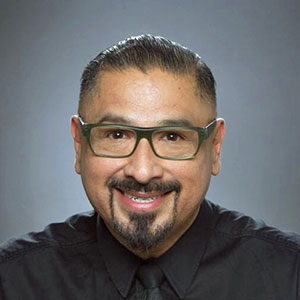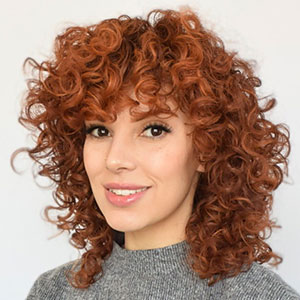
Get the latest Academy content and special deals direct to your inbox
When it comes to razored layers, there are different ways to create them. In this video you will learn a classic long layered haircut that uses a Feather Styling Razor to create beautiful razored layers on straight hair. The techniques mentioned and described in this tutorial are foundational and fundamental to any razor haircutter’s knowledge. You can watch the video tutorial and follow along with the transcript below.
Welcome back to the Jatai Academy! Today we’re going to be doing a razor layered haircut with some thinning scissors for texture.

I’m going to use my Feather Styling Razor because it’s super sharp plus it has a built-in guard for safety. So I’m going to comb everything clean from the roots all the way down to the ends and then I’m going to go through and channel cut as I’m cutting the length.
So I’ll do a vertical channel and then when I get to the length I want, which is where my fingers are, I’ll start cutting to the right and that’s going to create separation and I’m going to cut length at the same time.
I want to make sure her head is tilted slightly forward so I can get a little bevel on my length as I’m cutting it. Now I’m going to use the center length as my guide and do the same thing on both sides until I get all of the length cut to the length that I want.
I want to keep this pretty long and the channeling allows me to really lighten the hair up without removing all of the length. So whenever you’re trying to create something that has an airiness to it I have to walk a tight row between enough texture to create the lightness and the airiness and then enough solidity so that it still looks like she has as thick beautiful hair.
Now I take my next section which is a parallel part to my first section which was the occipital to the mastoid. This is going to go from the drop crown to the top of the ears.
I’ll use my guide underneath and then hold my fingers, cut the length and then channel. So I’m showing you a couple of different methods of doing this.
I can channel and cut the length all at one time. I can cut the length and then channel. Or I can channel and then cut the length. So I’m mixing it up throughout the whole thing.
Be sure to follow us on your favorite social media @jataifeather
Just going to continue on cutting my perimeter length following the same methodology that I’ve been doing throughout the entirety of the haircut at this point, channeling, cutting my length.
And I’m not really paying attention too much to how much weight I’m removing as long as I get the texture right. Now we’re going to start our layering around the front.

I’m going to take a center section and I’m going to comb this out off the peak curvature of the head and then I’m going to take a very very long soft razor stroke and cut my guide length.
I want to keep it fairly long because the more that I texturize and the more that I thin the hair, the shorter that it’s going to appear.
So I want to make sure that I leave a little bit of a safety net so that I don’t end up with some bangs that look like she’s really surprised or she’s got a third grade picture where Mom and Dad cut her bangs a little bit too short because they couldn’t get it even.
So I take my guide length in the middle and I work that down towards the edges over the ear and I’m gradually getting longer as I go to the sides.
I’m not worried about the guide length that I have in the back. I just want to get a general long length on the front and then as I work to the back I can increase my length to make sure I don’t cut off all the length in the back.
Right there on the front I wanted to take a little more hair out there. I thought it was a little thick. Now I’m going to go through and do the same thing on the left side using my guide in the center pulling the hair forward and down and then cutting my line short to long and using the same razor stroke that I’ve used throughout the entirety of this front section.

As I get to the bottom, I’m working my length to get longer so that I don’t start cutting into my perimeter length in the back. Do the same thing on the right side. Just comb everything forward and down, follow my guide underneath and then work from short to long.
Now you’ll notice I’m cutting from the center of the head to the perimeter on both sides so it’s always going centered down. On the right side I have to cross over my hand so that when I razor down I can continue with the same sort of razor stroke that I had on the other side.
Just continue to follow my guide down until I start to run out of hair and until it blends into my length in the back. After I’ve run out of hair and I’ve got everything blended through, I’m going to go through it now and start using that length in the front as the guide for my layering.

It’s going to be shorter right here at the top of the head and then as I start to work back I’m going to angle my fingers so that that line gets longer as I’m going further in the back of the head.
And as I start to round out I will still increase my angle so I save my length on the back. I’m creating a lot of layering but most of the layering here is going to be at the very very top of the head right at the high point of the head.
And as I work back towards the center it’s going to get longer and less layered. From here I’m using my center guide from the high point of the head.
I’m pivoting down to the corner of the hairline combing those two sections together pulling it straight up at 90 degrees from the head and then using my center section as my guide and cutting anything that hangs over that off, keeping a very very broad stroke so I can keep everything nice and soft.
Now at this next section I’m pivoting. I remove my original center section and now I have the second section and I’m creating the third section so that I have second and third sections together.
You can see the corner of the hairline to the mastoid right behind the ear. This is allowing me to work my layering shorter in the middle and keeping that same length as I work towards the ears.
If I converge everything by pulling it to the center it’s going to get longer and heavier behind the ears and I want to keep this layering in the back very very broad and evenly layered around the back. So by walking my guide like this, I can keep all the layering consistent on both sides and consistent throughout.
Now from here I’ll take my third section and I’m pivoting from the high point of the head right to the high point of the hairline over the ear.
Right at the ear is going to separate the front of the head from the back of the head so this is going to be where my layering in the front starts to take over from the layering on top.
So I’m going to have very very little hair that I need to layer through here and it’s more of a formality just to make sure that I don’t have anything that really hangs over the back. This section there should be very little if anything that hangs over what I cut around my quarter part.
Making sure everything blends nice and through. My layering here it’s nice and even across the whole back. It doesn’t get longer towards the ears.

I’m going to pull the section forward and then I’m going to go through and start thinning vertically. I’ll go through and take a little hair pull that out, take a little more hair pull that out, take a little hair pull it out.
So I’m starting no deeper than halfway through the section. If I go deeper than halfway I run into the possibility of there being little alfalfas that will stick up especially if they have kind of curly or wavy hair.
So I’ll start halfway in the middle of the section. I’ll hit it a couple of times as I work towards the tip. When I get to the very last part of that section at the very tip, I’ll use my thinning scissor and pull that out of my hand so I can work into my hand and not thin the same hair over and over and over again.
Here, I’m going to take out my section on the front. I’m not using a guide for this. I’m using the thickness of the hair to be my guide, how many hits of the thinning scissor that it needs to have. I’ll continue to section, pivot that section around the back.
If the hair is thicker I thin it a couple of more times. If it’s thinner maybe I don’t thin it quite as much and quite as deep but I definitely want to go through and remove a lot of the weight from the ends.
By removing weight from the ends that’s going to allow me to get a much more piecey look and it’s going to remove all that stiffness that I get when I built my shape in the beginning if the hair is too thick. Thick hair doesn’t move. Thinned textured hair moves.

If I see anything that needs a little bit more work here at this point when it’s dry I can really see how much weight I need to remove and then I can adjust accordingly. Everything looks pretty good.
Please check out the Jatai Academy. There’s all kinds of great information on there that’ll make you a better hair stylist and barber. Let us know what you’d like to see in the future and thank you so much for watching. We’ll see you next time!
Here’s the final look. As you can see the long razored layers add texture and movement. But the layers are not overpowering. This is a classic long layers razor haircut.

JATAI provides innovative and professional quality beauty implements with world-class customer service and educational support. To offer great products as a master distributor, we seek out and select only manufacturers who demonstrate superior workmanship, the most advanced technology, and respected business core values of reliability, honesty and integrity. Accordingly, JATAI represents three major ‘workhorse’ brands that dominate within their categories. Feather, Seki Edge and Fuji Paper. JATAI Academy brings beauty tools to creative life. It’s the ultimate professional information resource where Education, Artistry and Trends CONNECT for Stylists and Barbers.









